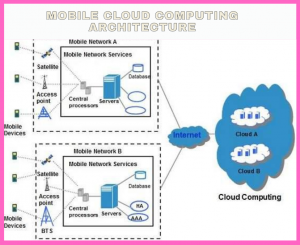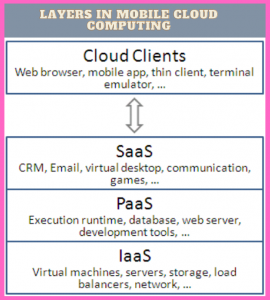Cloud computing
What is cloud computing?
Cloud computing is accessible on request and includes the delivery of certain resources over the Internet. Many of the services are listed in different forms below. A user can access electronic storage on clouds and can exchange files, databases, and programs on the network. The resources are available via the charge-as-you-go network.
Characteristics of cloud computing:
Cloud storage is indeed an application, as it supplies the computer as well as other portable devices on request with the information and common tools. Some essential cloud computing characteristics are as follows: Cloud computing resources are accessible from the internet. For instance mobile devices as well as other workspaces, these resources assist the user platforms. The customer has access to the applications and other tools required by the user. We do not get in contact with the cloud service provider (CSP). The user interacts with the necessary data mainly using web-based services.
What is Mobile cloud computing?
Mobile cloud infrastructure is becoming a future platform for different forms of services for smartphones, with the exponential growth of mobile apps and cloud computing. Mobile cloud computing brings cloud computing together in the mobile environment and defeats obstacles affecting the efficiency of mobile devices such as battery life, bandwidth, and storage, as well as other functionalities such as scalability, mobility, accessibility, and mobile technology protection and privacy. The primary aim of cloud service providers is to reduce the expense and implementation time and maximize income. Mobile apps are becoming a much-needed part of human life. These are basically powerful and acceptable communication devices that are not restricted to location and time. Smartphones and laptop PCs are such computers. Mobile computing’s rapid response is becoming a central feature in the fields of education, retail, online business, gaming, and every area of life using cell phones to carry out their daily functions. Cloud computing is improving the technology industry. In the cloud, individuals perform several tasks online. Mobile devices use smartphone software to conduct various services ( e.g., play store with iPhone apps). Such systems operate on wireless networks and data centers. The area of mobile app growth is growing with each day. As handheld apps have other advantages.

Figure 1. Mobile cloud computing Architecture
The architecture of Mobile cloud computing.
Throughout mobile cloud networking infrastructure, mobile nodes play a key role throughout linking various mobile devices to each other with a network via a base station. Definitions of the base station are the satellite, wireless network, cellular base networks, such channels set up and manage communications, communications, and usable interfaces between networks and mobile devices. Central processors are linked to websites, and requests from smartphone subscribers are sent to such servers, and then all facilities are offered to phone users by such data centers. Mobile network providers provide customers with a service and offer verification and authorization to consumers for connectivity to the portal. After the customers, the queries get sent to the cloud via the network. Cloud managers also provide infrastructure and process user-sent requests. Such systems are designed using the principle of computing services, service-oriented architecture, and virtual servers. In rare cases, the components of cloud computing are significantly different. Cloud computing uses four layers of structure, which is a widely distributed network
System; several servers become distributed networks in this system. Cloud services are based on a layer basis. Such systems are platform as a service ( PaaS), infrastructure as a service (IaaS), and software as a service (SaaS).
The layers in Mobile Cloud services:
Data-center layer: This layer has the function of supplying the cloud with physical service. Connects to a super-fast network in the network infrastructure layer and provides the infrastructure to customers’ servers. Such network devices are constructed on a site where there are fewer communities; there is indeed a strong power supply of permanence, and the level of risk is small.
Infrastructure as a service (laaS): As a utility, it is placed on top of the network infrastructure layer network. The IaaS allows the requirement of hardware, network, data centers, and bandwidth. The expense is based on the resources that the customer uses only, depending on the use of a service s customer can save costs.
Platform as a service (PaaS): Custom applications require PaaS development, installation, and developing an ecosystem to provide an efficient and optimized framework for all procedures to be conducted. Several service providers companies that are providing services in the cloud are Microsoft Azure, with the basic Amazon map that cloud storage, google play store Engine.
Software as a service (SaaS): The program offers assistance with specific specifications for software delivery. Users can access any program and information over the internet remotely. The consumer just charges for their own use. One of the interesting aspects of delivering this company sales team is. This institution offers the exchange of files and directories among multiple Microsoft Live Cluster apps.

Figure 2. Layers in Mobile Cloud Computing
Advantages of clouds for the services of Mobiles:
- Scalability: Versatile capacity planning seeks to fulfill the volatile consumer demands for mobile apps to scale and deploy. The program and functionality are quickly introduced and extended by a service provider through resource use constraints.
- Dynamic provisioning: The dynamic on-demand allocation of a reservoir on a really well grained, self-service basis is an effective method for smartphone service providers and consumers to operate their applications exclusively from the improved asset situation.
- Integration Ease: Different systems can be combined easily from various service providers across the internet and cloud to meet and satisfy customer requirements.
- Multitenancy: Different service providers include, for example, owners of cloud services and internet companies with and share costs and strategies to help a variety of applications and a vast number of customers.
How Mobile Cloud Computing can be improved?
Improve information storage space and computing power: storage efficiency is a major concern for mobile devices. Mobile cloud computing implies that people can control a huge amount of data on the web over the network. The basic example of this is that Amazon’s online storage service allows digital file storage. Another illustration is the sharing of images which utilizes a huge cloud storage capacity for consumers from multiple places. After recording, the user can add images to the cloud. The consumers can connect all of the images from any computer and anywhere. The downside of the cloud would be that subscribers could save an amount of storage on smartphones so because cloud storage holds all of the user data. Facebook is perhaps the most effective technology for sharing photos on a social media website Image exchange is another example that exploits a huge storage space in the cloud for users from different locations. The user can upload pictures on the cloud after capturing. The user is able to access all the images from any device and from anywhere. The benefit of the cloud is that users can save a lot of memory on mobile devices because all the user data is stored on the cloud storage. Facebook is a social website that is the most successful cloud sharing images.